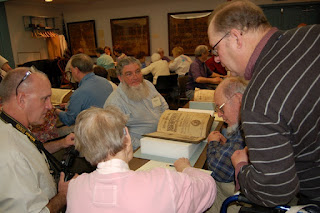 |
| Curator Kerry Mohn (right) with Winter History Class participants |
In the early 1740s, Mennonites in Pennsylvania wanted additional copies of the Martyrs’ Mirror, which chronicles the sufferings of the early Anabaptists. It was their hope to use the book as a source of instruction about the ideas of nonresistance. The problem in obtaining more copies of the massive volume, originally printed in Dordrecht in 1660, was that no help was forthcoming from friends in Holland. Taking matters into their own hands, representatives of the Franconia Mennonite Conference in eastern Pennsylvania approached the Ephrata Brotherhood to undertake the work.
 |
| Winter History Class participants examine copies of the Martyrs' Mirror |
Peter Miller, working from an illustrated copy printed in Amsterdam in 1685, translated the more-than-one-thousand-page book from Dutch to German. Over the course of three years, fifteen Brothers worked setting type and printing this book on paper made in the Community’s paper mill. The completed book was the largest book printed in the English colonies before the Revolution! Along the way, they made a few mistakes. Pages were mis-numbered, different decorations were used, and in some cases, a pictured frontispiece was included in the binding. These variations were the focus of the Winter History Class participants.
 |
| Title page from one of the Muddy Creek Farm Library editions Note the identification of Ephrata as the place it was printed |
Unfortunately, the participants did not discover any previously unknown or rare varieties in the Martyrs’ Mirrors in the Cloister’s collection. The class members were able to see some of the more common varieties contained within the books in the collection. Five copies that were on exhibit for the class courtesy of Amos Hoover and The Muddy Creek Farm Library had a number of very rare varieties for the participants to see. The genesis for this examination of the Ephrata collection is an ongoing research project being conducted by the Young Center at Elizabethtown College, begun two years ago as part of a conference observing the 350th anniversary of the first printing of the Martyrs’ Mirror.



0 comments:
Post a Comment